|
Sooty Tern Sterna fuscata Charrán Oscuro,
|
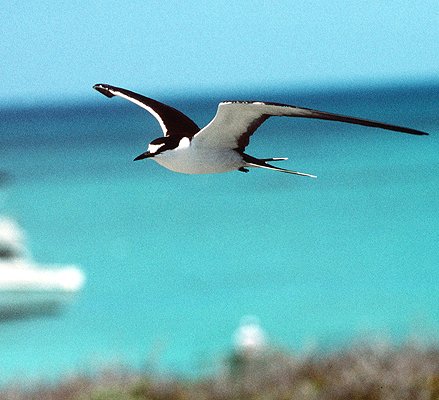 |
|
Photo: B. Hallett
|
|
Sooty Tern Sterna fuscata Charrán Oscuro,
|
 |
|
Photo: B. Hallett
|
|
IDENTIFICATION: Black above and white below. The white line on the forehead does not extend behind the eye, and the tail and back are blacker than in the Bridled Tern. Immatures are dusky, but all plumages have a forked tail. Length: 36-45 cm.; weight: about 200 g. VOICE: A nasal call, given incessantly at the nesting colony. Audio (N. Hopgood, J. Saliva). HABITAT: Except in the nesting season, this bird is highly pelagic and seen only far offshore. HABITS: Soars alone or sometimes with frigatebirds over the open ocean in search of schools of fish. It will hover over a school and then snatch a squid or fish (typically 6-8 cm.) in a quick dive without entering the water. It may even catch a flying fish in mid-air, and sometimes feeds at night. In some regions, fishermen home in on hovering Sooty Terns as an indicator of productive fishing grounds. Like the frigatebird, its feathers cannot tolerate prolonged submersion in water, and some biologists theorize that it may sleep while flying. Starting in April, both sexes build a nest scrape in a colony. Unlike Sooty Terns elsewhere, which nest on bare ground, in most Caribbean colonies they prefer to nest under or near dense vegetation. The male and female incubate the single egg in 24-hour shifts over a 30-day period. The young fledge at about eight weeks of age, but the parents continue to feed the young for three weeks after they are able to fly. The Sooty Tern typically does not breed until 3-5 years of age. Some Sooty Terns have lived as long as 32 years. STATUS AND CONSERVATION: Locally common in coastal Puerto Rico during the breeding season from April to September. It has not been recorded between October and March. Although Sooty Terns are site tenacious, recruitment from other colonies (as far as Florida) has been documented through leg banding studies. As many as 14 predator species prey upon eggs, chicks, or adult Sooty Terns. Nest predators include crabs, Laughing Gulls, American Oystercatcher and Ruddy Turnstone. Egg harvesting, although illegal, continues at the Culebra colonies. Protection of nesting colonies from predators and human disturbance is essential. The West Indian breeding population is estimated at 200,000-300,000 pairs. RANGE: Tropical oceans throughout the world. Regularly seen off the nesting colonies on Culebra, Monito, and Mona Islands and La Cordillera Nature Reserve during the breeding season. TAXONOMY: CHARADRIIFORMES; LARIDAE; Sterninae |
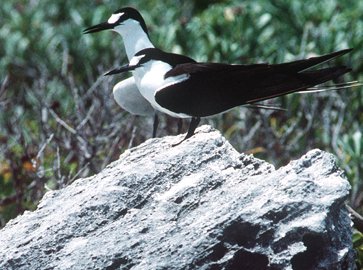 |
|
Photo: B. Hallett
|
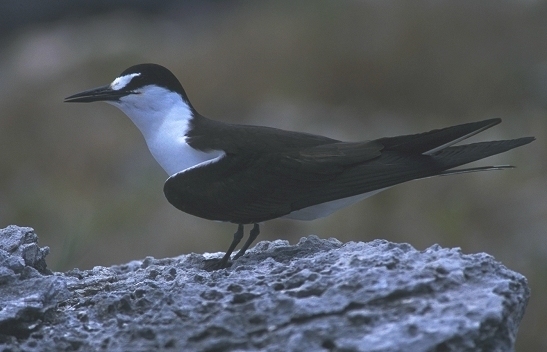 |
|
Photo: B. Hallett
|
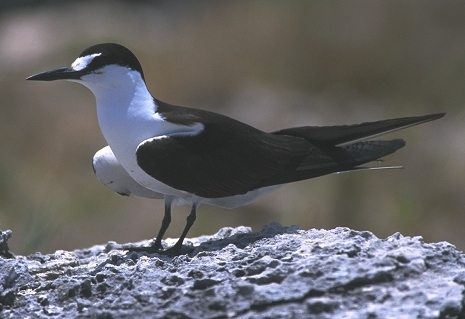 |
|
Photo: B. Hallett
|
 |
|
Photo: B. Hallett
|
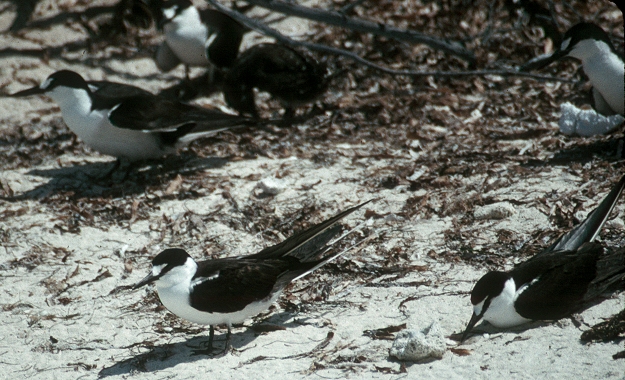 |
|
Photo: G. Beaton
|
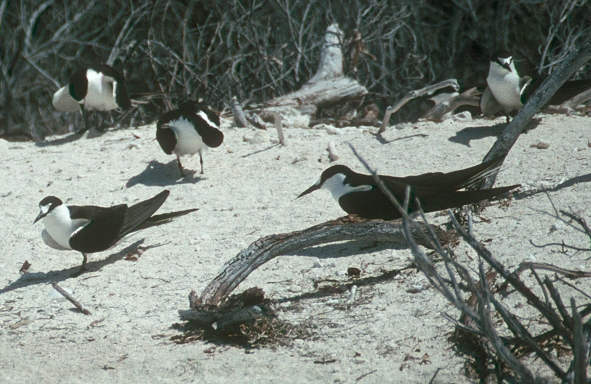 |
|
Photo: G. Beaton
|
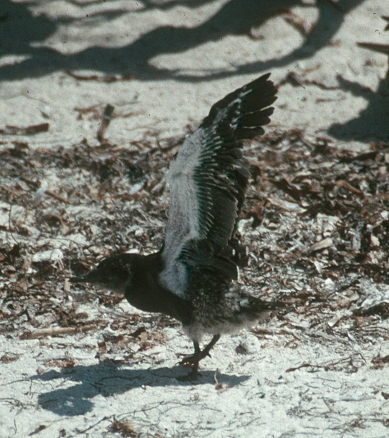 |
|
Chick - Photo: G. Beaton
|
|
References Bent, A.C. 1921. Life histories of North American gulls and terns. Smithsonian Instit. U.S. National Museum Bull. 113. (Reprinted by Dover Press, 1963). Burger, A. E. and A. D. Lawrence. 2000. Seabird monitoring techniques. Pp. 148-173 in Status and conservation of West Indian seabirds (E. A. Schreiber and D. S. Lee, eds.). Soc. Carib. Ornith., Special Pub. No. 1. Dammann, A.E. and D.W. Nellis. 1992. A natural history atlas to the cays of the U.S. Virgin Islands. Pineapple Press, Sarasota, FL. del Hoyo, J., A. Elliott, and J. Sargatal, eds. 1996. Handbook of Birds of the World, Vol. 3. Hoatzin to Auks. Lynx Edicions, Barcelona. Ehrlich, P.R., D.S. Dobkin, and D. Wheye. 1988. The birder's handbook: a field guide to the natural history of North American birds. Simon and Schuster/ Fireside, NY.
Harrison, P. 1983. Seabirds: an identification guide. Houghton Mifflin, Boston. Harrison, P. 1987. A field guide to seabirds of the world. Stephen Greene Press, Lexington, MA. Meier, A. J., R. E. Noble, and H. A. Raffaele. 1989. The birds of Desecheo Island, Puerto Rico, including a new record for Puerto Rican territory. Carib. J. Sci. 25:24-29. Raffaele, H.A. 1989. A guide to the birds of Puerto Rico and the Virgin Islands. Princeton. Raffaele, H.A. 1989. Una guía a las aves de Puerto Rico y las Islas Vírgenes. Publishing Resources, Inc., Santurce, PR. Raffaele, H.A., J.W. Wiley, O.H. Garrido, A.R. Keith, and J.I. Raffaele. 1998. Guide to the birds of the West Indies. Princeton. Rolle, F. J., H. Heatwole, R. Lewins, and F. Torres. 1964. Faunal notes on Monito Island, Puerto Rico. Carib. J Sci. 4:321-322. Saliva, J.E. 1992. Studies of Sooty Terns Sterna fuscata in Culebra. Ornitología Caribeña 3:58-59. Saliva. J. E. 2000. Conservation priorities for Sooty Terns in the West Indies. Pp. 103-108 in Status and conservation of West Indian seabirds (E. A. Schreiber and D. S. Lee, eds.). Soc. Carib. Ornith., Special Pub. No. 1. Schreiber, E. A. 2000. Action plan for conservation of West Indian seabirds. Pp. 182-191 in Status and conservation of West Indian seabirds (E. A. Schreiber and D. S. Lee, eds.). Soc. Carib. Ornith., Special Pub. No. 1. Schreiber, E. A., C. J. Feare, B. A. Harrington, B. G. Murray, Jr., W. B. Robertson, Jr., M. J. Robertson, and G. E. Woolfenden. 2002. Sooty Tern (Sterna fuscata). In The Birds of North America, No. 665 (A. Poole and F. Gill, eds.). The Birds of North America, Inc., Philadelphia, PA. Schreiber, E. A. and D. S. Lee. 2000. West Indian seabirds: a disappearing natural resource. Pp. 1-10 in Status and conservation of West Indian seabirds (E. A. Schreiber and D. S. Lee, eds.). Soc. Carib. Ornith., Special Pub. No. 1. Wiley, J. W. 2000. A bibliography of seabirds in the West Indies. Pp. 192-225 in Status and conservation of West Indian seabirds (E. A. Schreiber and D. S. Lee, eds.). Soc. Carib. Ornith., Special Pub. No. 1. Video: Hopgood, N. M. and J. Saliva. 1996. Sooty Terns of Culebra Island. Audio Visuales del Caribe. Gertrudis 20, San Juan, PR 00911-1304. Next related species in taxonomic order Previous related species in taxonomic order |